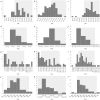Chikungunya outbreak in Bangladesh (2017): Clinical and hematological findings
- PMID: 32092073
- PMCID: PMC7058364
- DOI: 10.1371/journal.pntd.0007466
Chikungunya outbreak in Bangladesh (2017): Clinical and hematological findings
Abstract
Introduction: A massive outbreak of chikungunya virus (CHIKV) occurred in Bangladesh during the period of April-September 2017, and over two million people were at risk of getting infected by the virus. A prospective cohort of viremic patients was constituted and analyzed to define the clinical, hematological, and long-term aspects of this outbreak.
Methods: A 35-day long comprehensive survey was conducted in two major, neighboring cities, Dhaka and Mymensingh. One-hundred and eighty-seven laboratory-confirmed CHIKV cases were enrolled in the cross-sectional cohort study. Additionally, a smaller group of 48 chikungunya patients was monitored for post-infection effects for 12 months.
Results: Clinical data revealed that a combination of fever and arthralgia (oligoarthralgia and/or polyarthralgia) was the cardinal hallmark (97.9% of cases) of the infection. Hematological analysis showed that irrespective of age and sex groups, CHIKV patients had a decreased level of hemoglobin (n = 64, p < 0.01) and elevated erythrocyte sedimentation rate (n = 131, p < 0.01). Besides, a significant portion of the patients represented abnormal values for RBC (n = 38, p = 0.0005) and WBC (n = 63, p < 0.01) counts. The post-infection study revealed that children had an early recovery from the infection compared to the adults. Moreover, post-infection weakness, successive relapse of arthralgic pain, and memory problems were the most significant aftereffects, which had an impact on the daily activities of patients.
Conclusions: This study represents a comprehensive overview of clinical and epidemiological features of the 2017 outbreak of CHIKV in Bangladesh as well as its chronic outcomes till the 12th month. It provides insights into the natural history of this disease, which may help to improve the management of CHIKV patients.
Conflict of interest statement
The authors have declared that no competing interests exist.
Figures





References
-
- Brighton SW, Prozesky OW, De La Harpe AL. Chikungunya virus infection-A retrospective study of 107 cases. South African Medical Journal. 1983;68(9):313–5. - PubMed
MeSH terms
LinkOut - more resources
Full Text Sources
Medical
Miscellaneous

